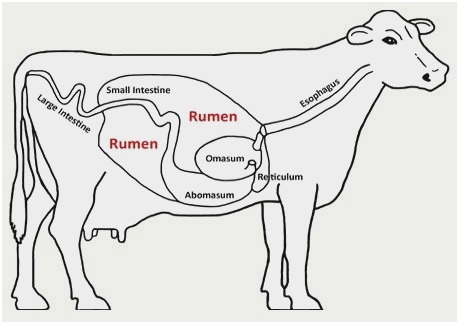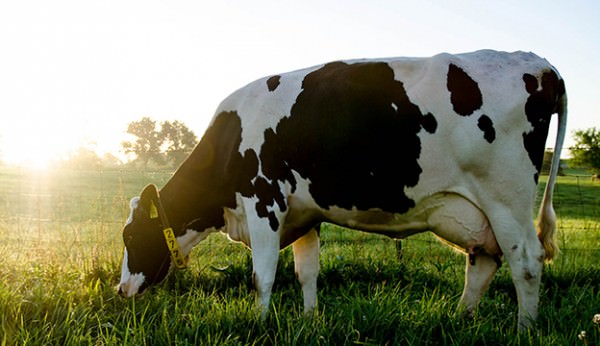Developing the diets and feeding strategies for the cowherd are facilitated by a basic understanding of the production cycle of the cow and its changing nutrient requirements. By knowing and anticipating the changing nutritional needs of the cow, producers can plan their feeding programs and lower feed costs.
Digestive System of Cattle
Digestion in ruminants differs markedly from that of other animals since cattle, sheep, goats, antelope, buffalo and camels are equipped with a large forestomach or paunch which acts as a fermentation vat.
In mature cattle, the rumen or paunch holds as much as 182l. A large amount of roughage is swallowed and retained in the rumen. When liquid is swallowed it passes the rumen via the oesophageal groove into the reticulum or honeycomb compartment and from there into the omasum (or manyplies) and finally to the abomasum or true stomach.
For efficient digestion, ruminants do not rely on digestive juices. Actually, the secretion of large amounts of ptyalin in the abundant supply of saliva in cattle would cause the formation of chronic bloat.

In the rumen many millions of micro-organisms set to breaking down the fibrous material, which process is facilitated by the rumen churning movements. For ideal growth and function, these organisms need a 6,8 to 7 pH medium in the paunch, as well as an optimum nutrient medium consisting of proteins, sugars and minerals, especially phosphorus and copper - all substances, that are known to promote fermentation.
After 24 hours of rumen fermentation and the secretion of as much as 5 kg of saliva, the ingesta is regurgitated for re-chewing of the cud before swallowing in sufficiently liquefied form to pass via the oesophageal groove to the reticulo-omasal orifice. The chief function of the reticulum omasum is to complete the work initiated in the rumen. The saliva contains considerable quantities of NaHCO3, mucin and NaC1. Secretion of saliva is stimulated by coarse roughage.
In the process of cellulose digestion of roughage by the micro-organisms, the inherent nutrients in the plant material are not only liberated to become available to the animal but the organisms themselves are carried through to the small intestine to be digested. The protein obtained from millions of digested organisms is of high biological value and contains the vitamins of the complex, as well as vitamin K.
Starches are hydrolysed in the rumen to dextrose, sugars and eventually such important energy-producing volatile fatty acids as acetic, propionic and butyric acids. Relatively little digestion takes place in the large intestine, but large quantities of water can be absorbed, especial in sheep. The undigested residue is voided as faeces.
Click here to view a video that explains basic cattle nutrition.
Converting Grass to Animal Products
Low-quality plant material such as grass can’t be used as food for people. Most of the country is covered by grassland and the only way in which to use this resource is to farm with grass-eating (ruminant) animals.
Ruminant livestock (animals that have a big stomach called / the rumen) can use and digest grass through a distinct process.
In the big stomach (rumen) there are billions of microorganisms (bacteria and yeast).The grass fibres are digested by enzymes produced by these organisms as an animal’s own enzymes cannot digest grass.
This releases the individual nutrients in the grass (energy, protein, minerals and vitamins). These nutrients are then used by the organisms as food, and they grow and multiply.
One of the important nutrients released from the digested grass is protein.
The organisms in the rumen need protein from the grass to grow fast and multiply.
If protein in the grass is high, digestion will take place at a high rate.
These organisms are then digested in the milk stomach by enzymes produced by the animal; this releases the nutrients and allows them to be absorbed in the small intestine of the animal.
The rumen will empty faster, which results in the cow eating more.
When good-quality grazing (high protein) is available, the adult cow will eat an amount of grass (on a dry-out basis) equal to or larger than 2% of her body weight.
For a cow weighing 450 kg, it amounts to+- 9 kg of dry grass per day.
By using the unique ability of ruminant animals, low-quality plant material can be converted into a saleable product to provide an income.
The marketplace will determine the price for live animals as well as animal products. The farmer must provide the product that is needed by the market.

Digestion Process
Let us illustrate this distinct digestion process by showing and explaining what happens in the rumen and milk stomach.

Click here to view a video that explains ruminant digestion.